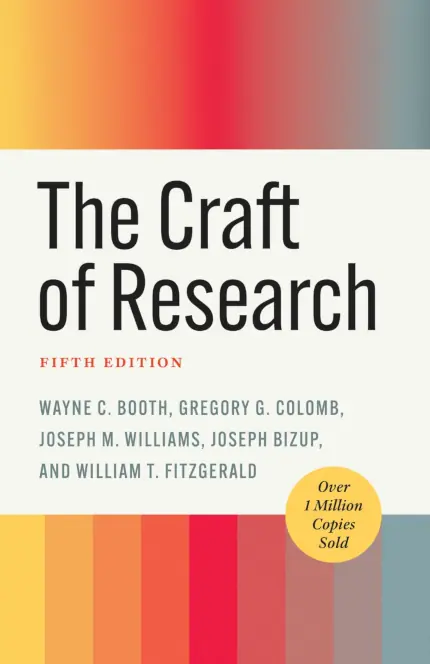Book Review
The latest update on a timelessly necessary subject and pursuit.
The first edition of The Craft of Research, Fifth Edition (published by the University of Chicago Press) was published almost thirty years ago, and now a fully updated fifth edition helps new students, readers, and researchers looking to learn. All editions have offered details on and advice for finding questions worth answering, developing projects to address problems, building serious arguments and addressing potential reservations, how to best revise written arguments and present research, and more. The latest edition continues with these main topics while adjusting to include new topics such as arising research technologies and guidelines for generative AI.

Research depends on the relationship between researcher and audience. Before beginning a project, let alone presenting it, four major questions need answering regarding probable audiences: with whom will the work be shared, what will the audience expect that a presenter should do, how much will the audience probably already know, and what is the likeliest response to the answer presented?
Research answers questions and solves problems. A problem in this context is not something more “practical” such as whether something is broken; rather, a research problem is about finding a way to fix a practical problem or find missing/necessary information. A practical problem will have a cost for no answer in the form of an unpleasant thing happening, while a research problem’s consequence is ignorance and lack of greater understanding.
Many beginning researchers will be assigned a topic, and that assignment should be the starting point for a question linked to their interest. But a bigger question needs asking about that question: why is it worth answering? Mere curiosity is not going to link an audience, who will want answers to questions such as “how”, “why”, and “wherever.”
There are three types of sources for researchers: primary, which presents the “raw data” and evidence; secondary, based on primary sources and intended for scholarly and professional audiences, useful to learn more about a topic’s preexisting research background and finding other perspectives and models; tertiary, which synthesize the scholarly secondary sources for more general readers, and as such should not be the most relied-upon source for research and arguments. There’s no better place to begin looking than the library and librarian, and the book gives advice on how to ask and how to set up that search.
But not all sources for research are created equally relevant and reliable. For finding the relevance of books, search for the right keywords and skim the bibliography; for articles, check the abstract (and keywords if available), section headings, and bibliography. Good papers should be well-organized and clearly outlined…important to remember when writing. Personal judgment is necessary to evaluate a source’s reliability, and there are signs to indicate reliability: the reputability of its author and/or publisher, whether it was peer-reviewed, if a public website has reputable sponsors, how up-to-date the source is, any bibliographic data if available, and more. Critical thinking will still be involved in sniffing out unreliable sources. The Craft of Research does an excellent job providing links to reliable databases such as WorldCat, JSTOR, and more.
Research arguments, however, can’t wait till all the data has been rounded up. Direction is needed to know what data to look for and what to preserve, even if plans change along the way. A research argument is composed of a claim, supported by evidence-based reasons, along with an acknowledgment of and response to other perspectives, and sometimes an explanation of reasoning principles. When creating a claim, three questions need to be asked:
- What kind of claim should it be?
- Is it specific enough that it suggests an argument?
- Will an audience think it is significant enough to need a supporting argument?
Claims usually fall into (though not exclusively) five claims: fact/evidence, definition/classification, cause/consequence, evaluation/appraisal, action/policy. Each requires a certain kind of evidence to prove the accuracy of a claim’s background. Reasons, distinguished from evidence, help plan the argument.
The importance of acknowledgements in an argument comes from the fact that research arguments are interactions with a larger context. An audience will be asking about the argument’s “worth”, its coherence/clarity/quality, and alternatives regarding potential solutions or other preexisting perspectives. Selecting what to acknowledge and respond to should be prioritized by:
- Plausible and reputable weakness charges
- Alternative arguments important within the field
- Alternative conclusions that audiences will hope are true
- Important counterexamples that require addressing
If a weakness within an argument can’t be fixed, redefined, or rebuilt, then said weakness merits acknowledgement accompanied by the stance that the rest of the argument compensates for weaknesses, more research will help in avoiding further weaknesses, and that this argument is the best of all options.
Many research projects will require a formal presentation or paper, and the day for drafting arrives when the audience is clearly defined, the answers can be sketched in only a few sentences, and responses are at the ready for known questions. The Craft of Research thoroughly describes for papers the format/layout, the ways of incorporating sources and visuals, and several other details regarding the process, but its guidance on how to present is perhaps the most useful. Those reading a paper have the opportunity to go back, but a live audience requires extra care to ensure motivation and understanding. Presenters need to have organized notes to help them with tracking and cues, focusing on the most significant parts—and most importantly, practice.
Even a book this consistent and well-rounded has limitations on what it can discuss, and to compensate for those limitations, The Craft of Research includes lists of other guides for further help. From general research to research methods, to subjects such as social sciences and STEM, to writing of all kinds, this book came equipped to equip.
The Craft of Research is an exemplar of what good research projects should be: organized, knowledgeable, full of resources and citations, and well-presented to an audience. The information is out there; it’s just a matter of how to find it and how to use it, to be both a better researcher and a better person. And this book is fully ready and able to help.
By: Grace Dietz
Grace is an Editorial Assistant at Technica Editorial




